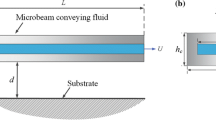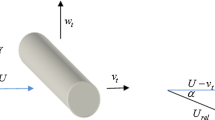Abstract
The purpose of this paper is to develop a theoretical model for predicting the dynamics and pull-in mechanism of electrostatically actuated microbeams containing internal fluid flow. By considering the effects of nonuniform profile of the flow velocity, material length scale parameter of the microbeam and nonlinear electrostatical force, the equation of motion of the microbeam has been presented. The lateral displacement of the microbeam consists of two parts: a static (steady) displacement and a perturbation displacement about the static. Based on the general differential quadrature rule, the static deflection of the microbeam is calculated numerically. The obtained static deflection is then used to solve the equation governing the perturbed displacement. The natural frequency and flow-induced instability of the microbeam are analyzed for both clamped–clamped and cantilevered boundary conditions. Results show that the internal fluid flow could dramatically affect the static deflection of the microbeam and hence the pull-in voltage. The electric voltage, on the other hand, would significantly influence the dynamics of the microbeam.







Similar content being viewed by others
References
Chang TP (2013) Nonlinear thermal–mechanical vibration of flow-conveying double-walled carbon nanotubes subjected to random material property. Microfluid Nanofluid 15:219–229
Chen JH, Kang SM, Zou J, Liu C, Schutt-Aine JE (2004) Reduced-order modeling of weakly nonlinear MEMS devices with Taylor-series expansion and Arnoldi approach. IEEE J Microelectromech Syst 13:441–451
Choi B, Lovell EG (1997) Improved analysis of microbeams under mechanical and electrostatic loads. J Micromech Microeng 7:24–29
Fang YM, Li P (2013) A new approach and model for accurate determination of the dynamic pull-in parameters of microbeams actuated by a step voltage. J Micromech Microeng 23:045010
Guo CQ, Zhang CH, Paidoussis MP (2010) Modification of equation of motion of fluid-conveying pipe for laminar and turbulent flow profiles. J Fluids Struct 26:793–803
Ho CM, Tai YC (1996) MEMS and its applications for flow control. J Fluids Eng 118:437–447
Ho CM, Tai YC (1998) Micro-electro-mechanical-systems and fluid flows. Annu Rev Fluid Mech 30:579–612
Hung ES, Senturia S (1999) Extending the travel range of analog-tuned electrostatic actuators. J MEMS 8:497–505
Laser DJ, Santiago JG (2004) A review of micropumps. J Micromech Microeng 14:35–64
Mattia D, Gogotsi Y (2008) Review: static and dynamic behavior of liquids inside carbon nanotubes. Microfluid Nanofluid 5:289–305
Muldavin JB, Rebeiz GM (2000) High-isolation CPW MEMS shunt switches: part 1Modeling. IEEE Trans Microw Theory Tech 48:1045–1052
Nayfeh AH, Pai PF (2004) Linear and nonlinear structural mechanics. Wiley, New York
Nayfeh AH, Younis MI, Abdel-Rahman EM (2005) Reduced-order models for MEMS applications. Nonlinear Dyn 41:211–236
Osterberg PM, Senturia S (1997) MTEST: a test chip for MEMS material property measurement using electrostatically actuated test structures. J MEMS 6:107–118
Paidoussis MP (1998) Fluid–structure interactions: slender structures and axial flow, vol 1. Academic Press Limited, London
Pamidighantam S, Puers R, Baert K, Tilmans HAC (2002) Pull-in voltage analysis of electrostatically actuated beam structures with fixed–fixed and fixed–free end conditions. J Micromech Microeng 12:458–464
Pandey AK (2013) Effect of coupled modes on pull-in voltage and frequency tuning of a NEMS device. J Micromech Microeng 23:085015
Rinaldi S, Prabhakar S, Vengallatore S, Paidoussis MP (2010) Dynamics of microscale pipes containing internal fluid flow: damping, frequency shift, and stability. J Sound Vib 329:1081–1088
Ruzziconi L, Bataineh AM, Younis MI, Cui W, Lenci S (2013) Nonlinear dynamics of an electrically actuated imperfect microbeam resonator: experimental investigation and reduced-order modeling. J Micromech Microeng 23:075012
Sadeghian H, Rezazadeh G, Osterberg PM (2007) Application of the generalized differential quadrature method to the study of pull-in phenomena of MEMS switches. J Microelectromech Syst 16:1334–1340
Senturia S (2001) Microsystem design. Kluwer Academic Publisher, Norwell
Sheybani R, Gensler H, Meng E (2013) A MEMS electrochemical bellows actuator for fluid metering applications. Biomed Microdevices 15:37–48
Tilmans HAC, Legtenberg R (1994) Electrostatically driven vacuum-encapsulated polysilicon resonators: part II theory and performance. Sens Actuators A Phys 45:67–84
Wang L (2010) Size-dependent vibration characteristics of fluid-conveying microtubes. J Fluids Struct 26:675–684
Wang L, Liu HT, Ni Q, Wu Y (2013) Flexural vibrations of microscale pipes conveying fluid by considering the size effects of micro-flow and micro-structure. Int J Eng Sci 71:92–101
Xia W, Wang L (2010) Microfluid-induced vibration and stability of structures modeled as microscale pipes conveying fluid based on non-classical Timoshenko beam theory. Microfluid Nanofluid 9:955–962
Yang TZ, Jia SD, Yang XD, Fang B (2014) Microfluid-induced nonlinear free vibration of microtubes. Int J Eng Sci 76:47–55
Yin L, Qian Q, Wang L (2011a) Size effect on the static behaviour of electrostatically actuated microbeams. Acta Mech Sin 27:445–451
Yin L, Qian Q, Wang L (2011b) Strain gradient beam model for dynamics of microscale pipes conveying fluid. Appl Math Model 35:2864–2873
Younis MI, Abdel-Rahman EM, Nayfeh AH (2003) A reduced-order model for electrically actuated microbeam-based MEMS. J Microelectromech Syst 12:672–680
Acknowledgments
The authors gratefully acknowledge the support provided by the National Natural Science Foundation of China (Nos. 11172107 and 11172109), the Program for New Century Excellent Talents in University of China (NCET-11-0183), Natural Science Foundation of Hubei Province (2013CFA130), and the Fundamental Research Funds for the Central Universities, HUST (2012QN023, 2014YQ007).
Author information
Authors and Affiliations
Corresponding author
Rights and permissions
About this article
Cite this article
Dai, H.L., Wang, L. & Ni, Q. Dynamics and pull-in instability of electrostatically actuated microbeams conveying fluid. Microfluid Nanofluid 18, 49–55 (2015). https://doi.org/10.1007/s10404-014-1407-x
Received:
Accepted:
Published:
Issue Date:
DOI: https://doi.org/10.1007/s10404-014-1407-x




